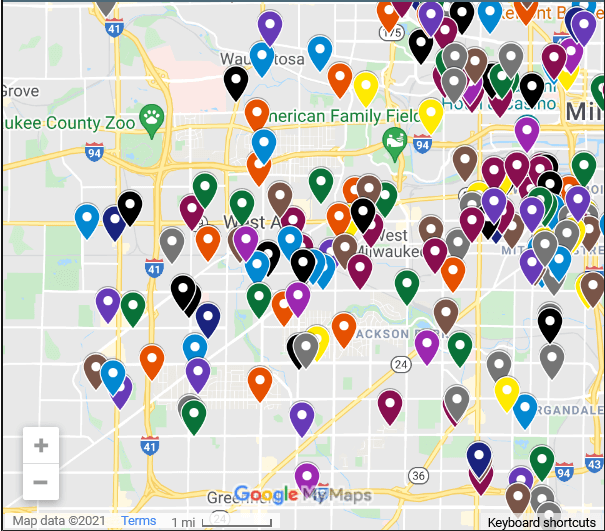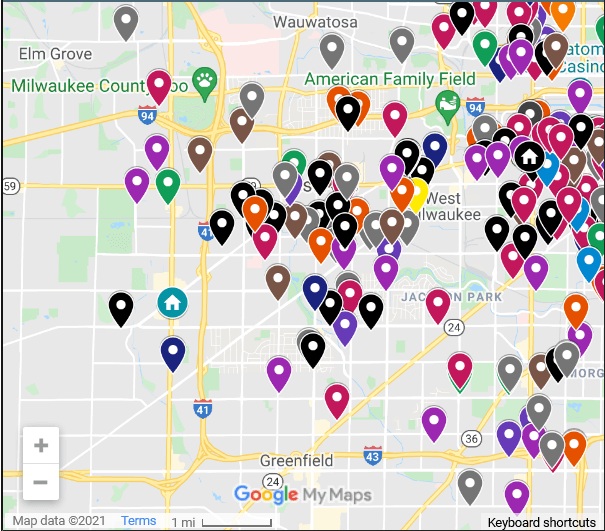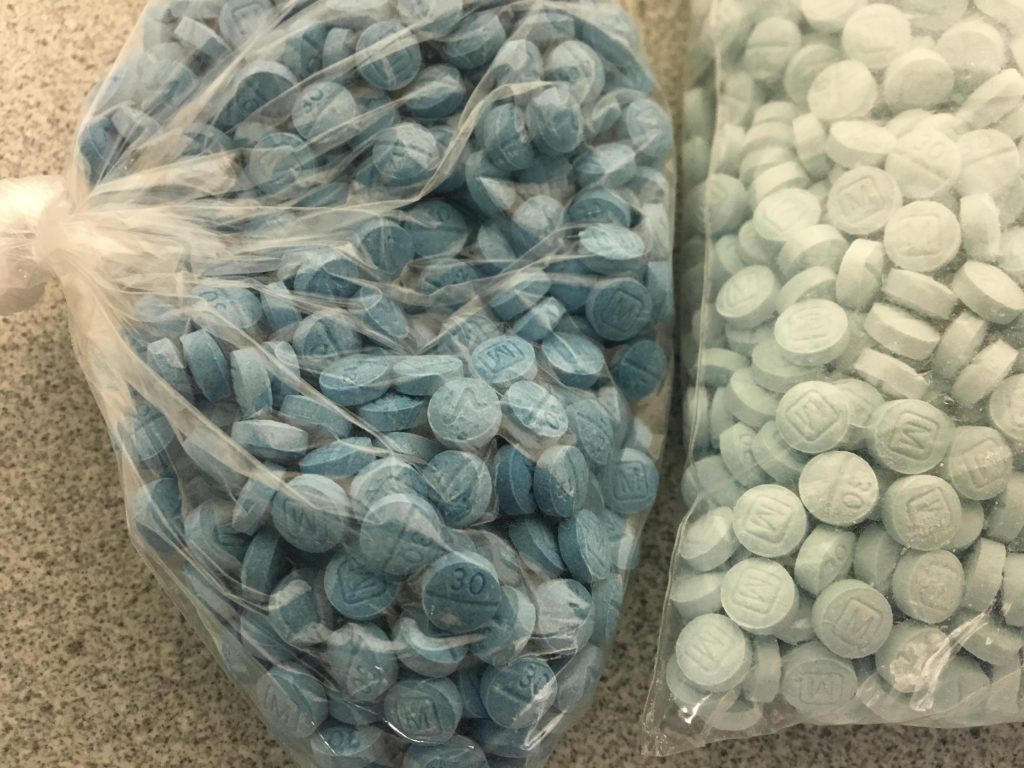Milwaukee Overdose Map Shows Deadly Toll of Fentanyl
Despite rising deaths, a treatment clinic faces community opposition in West Allis.
In Milwaukee County, 544 people died of a drug overdose in 2020. For the city and county it was a new record, breaking the previous one of 418 set in 2019. Treatment options have lagged behind the deaths that are overtaking communities. It’s a frustrating battle that Community Medical Services (CMS), a medication-assisted treatment center, has fought for over a year. A battle which, at times, is hampered by ingrained stigma and neighborhood residents who don’t want treatment centers nearby.
Such attitudes are sometimes referred to as NIMBY, or a “Not In My Back Yard” mentality. People may not object to a treatment center opening, just not near their homes. John Koch, Community Engagement Director for CMS, believes that “NIMBY is what’s stopping Milwaukee from addressing the opioid epidemic.” Koch stressed that “until people know that NIMBY’s going to happen but we got to stop deaths, and stand up for that, then Milwaukee will continue to have a problem.”
Amanda Rodriguez, community programs and integration manager at the West Allis clinic, highlighted the importance of teaming up with the city. “We have a partnership with the West Allis Fire Department,” Rodriguez explained. “It’s one of our peer supports along with two of the West Allis MIH [Mobile Integrated Healthcare] team.” As part of the team, a CMS peer support specialist joins firefighter and EMS medic personnel responding to non-fatal overdoses within West Allis.
“So they are engaging those folks and trying to get those individuals into treatment,” Rodriguez told Wisconsin Examiner. “Treatment is defined as whatever ‘treatment’ means to that individual. So, it could be getting them connected with housing resources, getting them connected with a treatment center that might not necessarily be ours … getting them food.” The work being done on the ground is also reflected in the data.
Wisconsin Examiner has mapped Milwaukee County’s overdose deaths for 2020, color-coordinated according to the drug(s) documented by the medical examiner’s office. Each point represents a human being who died of a drug overdose during an unprecedented year.
The interactive maps allow you to zoom in, and click on each point to see more details. However, the names of individuals have not been provided for their own privacy. Deaths which occurred in hospitals are also not included. This year’s map also shows where the two CMS clinics in Milwaukee are located. The map for 2019 published last year is also included as a comparison. However, the 2020 map includes more specific information to each individual.
Key: Black– mainly fentanyl | Purple – fentanyl with another drug like MDMA or oxycodone, but no heroin/cocaine | Brown – a combination of at least 3-4 drugs, at least one being fentanyl | Violet– heroin, cocaine, fentanyl |Yellow – cocaine and heroin, no fentanyl | Blue – mainly heroin | Red – heroin and fentanyl mainly | Green– mainly cocaine | Red Purple – cocaine and fentanyl mainly |Orange – meth is listed, no cocaine, heroin or fentanyl | Dark Blue – meth is listed with cocaine, heroin or fentanyl | Gray– other | House Icon- An existing or proposed Community Medical Services Clinic
The 2020 drug overdose death map
The 2019 drug overdose death map
New rash of cocaine deaths
A lot of information can be drawn from the maps, some data points more obvious than others. For one thing, as Rodriguez points out, “Folks out there are dying from cocaine. And we’ve never seen that happen before.” Driving the sharp rise in cocaine-related deaths is fentanyl, and it’s slew of relatives. Fentanyl-laced cocaine isn’t the only issue. Methamphetamine-involved deaths also rose from 16 in 2019 to 31 in 2020, and most of those also involved fentanyl. Some locations, like motels or apartment buildings, had multiple deaths under one roof.
The fact that seven out of the 12 color-coordinated drug categories Wisconsin Examiner used in the maps involve fentanyl speaks for itself. Deaths which involve heroin without fentanyl are increasingly rare. The word “fentanyl” is found in 408 of the 544 drug-related deaths recorded in 2020. That’s including fentanyl analogs like cyclopropyl fentanyl, Acetylfentanyl, and beta-hydroxy fentanyl.
Drugs such as gabapentin and Isotonitazene—the latter of which first made an appearance in Milwaukee during 2020—were also reoccurring in the data. In 2018 gabapentin was found in 13 drug-related deaths. In 2019 the number was 39. During 2020, it was found in 59 drug-related deaths. The medical examiner’s office has noted that the concentrations of gabapentin they’re finding in victims are beyond therapeutic levels. Studies have shown that 40-65% of people prescribed gabapentin misuse it, and 15-22% of people who abuse opioids also abuse gabapentin.
Along with overdoses, spending on drug enforcement in the city is also up. In May, the Common Council voted to approve federal grants associated with Milwaukee’s High Intensity Drug Trafficking Area (HIDTA) operations. Last year Milwaukee HIDTA seized 240 illegal guns and 297 kilograms of cocaine, worth nearly $30 million on the street. According to Urban Milwaukee, another seven kilos of methamphetamine, 26 kilos of heroin, and two kilos of fentanyl were seized by the drug enforcement unit. The HIDTA grants were accepted in the wake of the federal Community-Oriented Policing Services (COPS) grants, which were accepted by the council after some debate.
Tangible results
Which methods have the best results? Comparing the maps for 2019 and 2020 for areas around West Allis, there’s a noticeable absence of deaths around the CMS clinic in 2020. Rodriguez points to the partnerships CMS has forged with the city, and particularly with the fire department, as a factor. Improvements were also seen in the West Allis Fire Department’s own data collection. A seven-page report for the Police and Fire Commission highlighted a lot of that progress.
The 2019 drug overdose death map

A screenshot of drug deaths in the West Allis area during 2019. Notice the wide spread toward the west. Screenshot/Wisconsin Examiner.
The 2020 drug overdose death map

A screenshot of drug overdoses in the West Allis area during 2020. Notice the icon where a Community Medial Serivces clinic is located, and how there are significantly fewer deaths in the area. Screenshot/Wisconsin Examiner.
“The West Allis Fire Department has successfully built one of the most effective and progressive substance abuse disorder programs in the nation,” reads the document, dated May 20, 2021. The report noted that in April, the Substance Abuse and Mental Health Administration (SAMSHA) accepted grant applications to further expand outreach teams which provide services to those battling opioid addiction.
Page four of the report includes a chart tracking the number of overdose incidents in West Allis, month by month, from 2019-2021. Using the start of the city’s addiction support services as an anchor, the chart shows that overdoses during 2020 dropped between June and November, as compared to 2019. Overdoses in 2020 were higher than average in general, however, particularly in the months before the start of support services.
“In 2020,” a section of the report reads, “the number of overdose incidents had been higher than average. This exceptionally high average is partly attributed to COVID-19 as the pandemic greatly reduced the availability of Substance Use Disorder (SUD) support services including MIH outreach. To combat the high numbers of overdoses MIH services have been expanded to include a targeted community outreach that aims at connecting residents affected by SUD to recovery services. Since outreach services have begun, overdose statistics have fallen and remained at all-time lows.”
In a short period of time, CMS has been able to utilize a wide-ranging support network for its West Allis operations. “We have a lot of other community partners involved with this,” said Rodriguez. Through a partnership with UMOS, the clinic was provided kits with harm reduction supplies to distribute. “It has clean syringes, it has Narcan in it, it has condoms, it has resources,” Rodriguez said. “We also have an amazing partnership with Street Angels and we are doing outreach with them.”
Street Angels does outreach for people struggling with addiction, and helps connect those individuals to services. Building those kinds of networks helps in, “breaking down those silos and those barriers for our patients, and giving them access to these resources that they are in need of,” said Rodriguez.
Breaking the cycle in Milwaukee
The results are encouraging, but a single facility can only do so much. Koch has warned that the West Allis clinic has neared its capacity, meaning soon it won’t be able to accept any more people. Additionally, his attempts to open a clinic somewhere in the City of Milwaukee have been fruitless. Koch’s first attempts on Milwaukee’s North Side were met by residents who were concerned and confused as to the clinic’s purpose.
Although the local alderperson supported the notion of opening a clinic, she ultimately sided with her constituents who thought a clinic would attract people who use drugs. Next Koch looked for a location on the South Side of Milwaukee which routinely experiences dense clusters of overdose deaths. In fact, according to the maps, the new clinic would have been located across the street from a dense cluster of cocaine/fentanyl combination deaths.
“We had been looking in that area,” Koch explained, “obviously your maps have shown that was a hot spot area.” However, similarly to what happened on the North Side, local opposition turned the area’s alderperson against opening a clinic. On April 1, the clinic was on the agenda of the city’s Board of Zoning Appeals’ (BOZA) agenda. CMS had come with several allies willing to voice their support, including a letter of support from Milwaukee’s Fire Department. Assistant Chief Joshua Parish called CMS “a valued partner of the Milwaukee Fire Department and Milwaukee Health Department’s Opioid Response Initiative since 2019.”
Parish wrote that Milwaukee, “much like other communities across the world, has seen an uptick in opioid related emergencies. These emergencies present themselves in people who are represented in all walks of life, all professional circles, and all racial and ethnic backgrounds. Efforts to provide rapid access to support services are equally as valuable as the locations of these services in communities of need, which also further reduces the stigma around substance-use disorder that adds to mortality and continued abuse. These services undoubtedly save lives and reduce the fatal impact of substance abuse that ravish families and communities alike.”
Once the item was taken up Ald. JoCasta Zamarripa rose to voice concerns from her constituents. As a result, the board decided to push the meeting off a month to allow for public comment on both sides of the issue. Shortly after the decision, CMS decided to withdraw its efforts to open a clinic at the South Side location. “That’s why no one will open in Milwaukee,” said Koch. If residents are not welcoming to the idea of a clinic in their area, it can be difficult to win an alderperson’s support.
Meanwhile the situation in Milwaukee, regardless of what end of town you live on, continues to worsen. The same month CMS’s new clinic was pushed off, Milwaukee Neighborhood News Service reported on how the city’s opioid task force had yet to meet in 2021. The 10-member group met four times in 2018, and just twice in 2019.
Other organizations continue to tackle aspects of the problem, sometimes with support from the county. Groups like Milwaukee Providing Opportunity for Wellness, Empowerment and Recovery (MPOWER), which provides housing resources to homeless and trafficked women. Or the Inner Beauty Center, which conducts street outreach to homeless and trafficked women, a demographic which also often suffers from addiction. Still, what resources are available are outpaced and overwhelmed by the need.
“Milwaukee’s one of the only cities in the United States where overdose deaths are more than COVID deaths,” said Koch. “We need relief for our West Allis clinic. We know that. So we’re working on that piece. The City of South Milwaukee clinic is running, and that’s going well.”
Milwaukee County’s Medical Examiner’s Office and the Medical College of Wisconsin are also set to receive $1.2 million in federal grants to fight the overdose epidemic. The money will be used to fund a Overdose Public Health and Safety Team. The team will develop strategies for preventing overdose deaths, with funding also going to “community resource dispatchers” that will connect people affected by the overdose crisis with resources. The pace of overdose deaths in 2021 is similar to last year’s, according to the Medical Examiner’s Office.
Rodriguez says she is rewarded by the faces of former patients who found hope through treatment. “It’s because of this community approach,” she told Wisconsin Examiner, “that we’re all on the same page, we all acknowledge that there’s this opioid epidemic going on right now, and we’re trying to figure out a better way to help solve this problem.”
Maps show Milwaukee’s overdoses on the rise without new treatment options was originally published by Wisconsin Examiner.
More about the Opioid Crisis
- County Executive David Crowley Hosts Roundtable on Combating Opioid Crisis and Saving Lives in Wisconsin - David Crowley - Dec 16th, 2025
- Co-Chairs Criticize DHS For Lack of Plan, Transparency with Opioid Settlement Funds - Joint Committee on Finance - Oct 21st, 2025
- Opioid Treatment Program Opens First Clinic in Milwaukee - Isiah Holmes - Oct 20th, 2025
- County Executive Crowley, Chairwoman Nicholson Sign Legislation Approving $9 Million for Efforts to Compat the Opioid Crisis - David Crowley - Aug 15th, 2025
- How Are State’s Local Governments Spending Opioid Settlement Payouts? - Addie Costello - Aug 4th, 2025
- MKE County: How County Will Spend $9 Million in Drug Settlement Funds - Graham Kilmer - Jul 29th, 2025
- Milwaukee County Executive David Crowley Announces Over $9 Million for Initiatives to Combat Opioid Epidemic - David Crowley - Jul 17th, 2025
- AG Kaul, 45 Other Attorneys General Plan to Join $720 Million Settlement with Eight Opioid Drug Makers - Wisconsin Department of Justice - Jul 14th, 2025
- Attorney General Kaul Announces Consent Judgment with Kroger Over Opioid Crisis - Wisconsin Department of Justice - Mar 21st, 2025
- Baldwin Votes to Strengthen Penalties, Step Up Enforcement Around Deadly Fentanyl - U.S. Sen. Tammy Baldwin - Mar 17th, 2025
Read more about Opioid Crisis here
Political Contributions Tracker
Displaying political contributions between people mentioned in this story. Learn more.
























